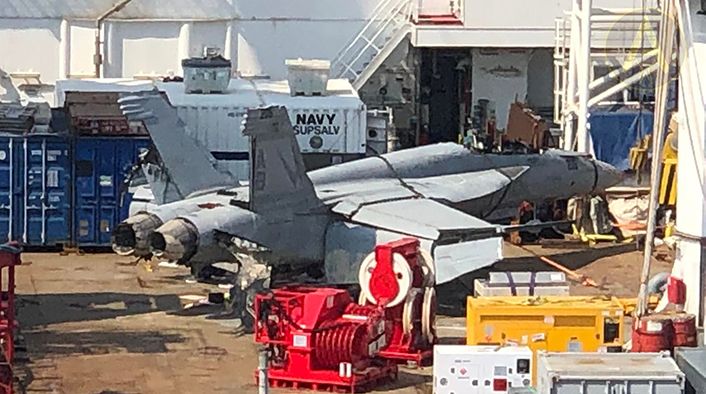The wreckage of the Super Hornet was successfully recovered from the Mediterranean Sea where it fell last month due to bad weather. We were sent a photo that allowed us to identify the F/A-18E.
On Jul. 8, 2022, an F/A-18E Super Hornet belonging to Carrier Air Wing 1 aboard USS Truman sailing in the Mediterranean Sea, blew off the flight deck of the aircraft carrier due to very bad weather. The mishap was not related to the aircraft going overboard during flying activity but it occurred as the carrier was hit by “an unexpected brief period of intense winds and heavy rains”. No one was aboard the F/A-18E at the time of the incident. One sailor was injured but in stable condition and anticipated to make a full recovery, U.S. 6th Fleet said.
As we commented back then, the incident was at least bizarre: while aircraft can go overboard during routine flight operations at sea, they shouldn’t be blown off the deck by weather. In fact, when rough seas or heavy weather is anticipated, aircraft and anything else that could potentially move, like tractors, carts, etc, are chained down when they are not used, so that they don’t fall from the flight deck.
Anyway, the U.S. Navy has announced that aircraft was successfully recovered from a depth of approximately 9,500 feet on Aug. 3, 2022, by a team from Task Force (CTF) 68, Naval Sea Systems Command’s Supervisor of Salvage and Diving (SUPSALV), Harry S. Truman, Naval Strike Fighter Wing Atlantic, and U.S. Sixth Fleet embarked on the multi-purpose construction vessel (MPV) Everest.
The aircraft was recovered using a CURV-21 remotely operated vehicle to attach specialized rigging and lift lines to the aircraft. A lifting hook was attached to the rigging to raise the aircraft to the surface and hoist it aboard Everest.
“The rapid response of the combined team, including SUPSALV and Phoenix International personnel, allowed us to conduct safe recovery operations within 27 days of the incident,” said Lt. Cmdr. Miguel Lewis, U.S. Sixth Fleet salvage officer in the naval service public release. “Our task tailored team operated safely and efficiently to meet the timeline. The search and recovery took less than 24 hours, a true testament to the team’s dedication and capability.”
Indeed, the recovery demonstrated the U.S. Navy’s capabilities to conduct deep-water search and recovery operations world-wide.
A similar operation had been launched after a British F-35B fell into the Med Sea during a failed take off from HMS Queen Elizabeth: it took two weeks to locate the wreck and another week to bring it up but the recovery was carried out so as to prevent that sensitive equipment on the aircraft could be found by Russian ships or submarines dispatched by the Russians most probably interested in studying the technologies aboard the 5th generation aircraft.
The Super Hornet also carries a radar, sensors and equipment whose loss to a hostile country would represent a significant security incident for the U.S., hence the need to recover the F/A-18E and all its payload (if any).
According to the U.S. Navy, the recovered aircraft was delivered to a nearby military installation where it will be transported to the United States.
A reader of The Aviationist who wishes to remain anonymous sent us this photo, taken recently at Augusta port, in Sicily, Italy, where the aircraft arrived before being moved to a base, possibly NAS Sigonella, from where it will be flown back to the US.
The aircraft was not covered, a sign that there was nothing to hide, however, the photo provides some interesting details: first of all the F/A-18E appears to be the airframe with Modex 205, assigned to Strike Fighter Squadron 211 (VFA-211), “Fighting Checkmates”. Then, dealing with the damage, the airframe shows no surviving horizontal stabilizers and damage to the engine nozzles areas and the left tail’s rudder. The canopy is also missing.









